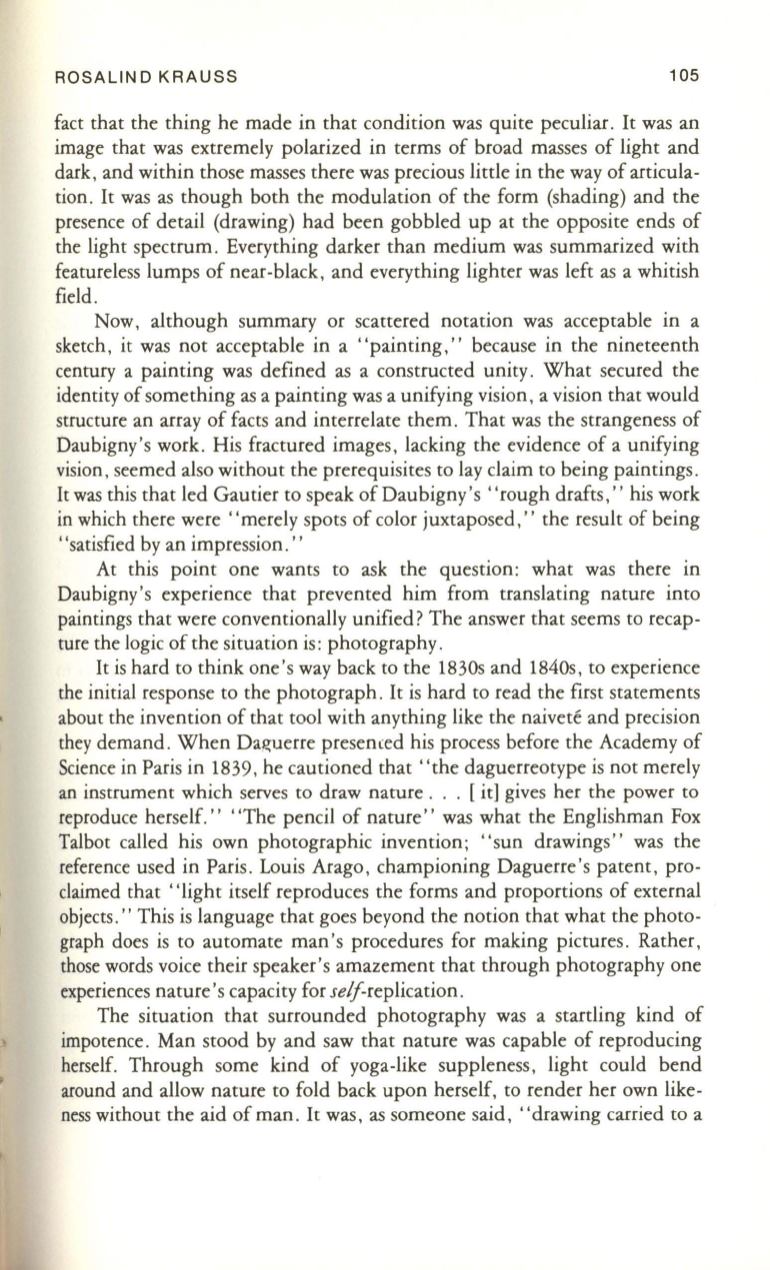
ROSALIND KRAUSS
105
fact that the thing he made in that condition was quite peculiar. It was an
image that was extremely polarized in terms of broad masses of light and
dark, and within those masses there was precious little in the way of articula–
tion .
It
was as though both the modulation of the form (shading) and the
presence of detail (drawing) had been gobbled up at the opposite ends of
the light spectrum . Everything darker than medium was summarized with
featureless lumps of near-black, and everything lighter was left as a whitish
field .
Now , although summary or scattered notation was acceptable in a
sketch, it was not acceptable in a "painting, " because in the nineteenth
century a painting was defined as a constructed unity . What secured the
identity of something as a painting was a unifying vision, a vision that would
structure an array of facts and interrelate them. That was the strangeness of
Daubigny 's work . His fractured images, lacking the evidence of a unifying
vision, seemed also without the prerequisites to lay claim to being paintings.
It was this that led Gautier to speak of Daubigny's "rough drafts, " his work
in which there were ' 'merely spots of color juxtaposed ," the result of being
" satisfied by an impression ."
At this point one wants to ask the question : what was there in
Daubigny 's experience that prevented him from translating nature into
paintings that were conventionally unified? The answer that seems to recap–
ture the logic of the situation is : photography.
It is hard to think one's way back to the 18305 and 1840s, to experience
the initial response to the photograph .
It
is hard to read the first statements
about the invention of that tool with anything like the naivete and precision
they demand . When Daguerre presenced his process before the Academy of
Science in Paris in 1839, he cautioned that "the daguerreotype is not merely
an instrument which serves to draw nature . .. [it] gives her the power to
reproduce herself. " " The pencil of nature" was what the Englishman Fox
Talbot called his own photographic invention ; " sun drawings" was the
reference used in Paris. Louis Arago, championing Daguerre 's patent , pro–
claimed that' 'light itself reproduces the forms and proportions of external
objects ." This is language that goes beyond the notion that what the photo–
graph does is to automate man's procedures for making pictures . Rather,
those words voice their speaker 's amazement that through photography one
experiences nature 's capacity for self-replication .
The situation that surrounded photography was a startling kind of
impotence . Man stood by and saw that nature was capable of reproducing
herself. Through some kind of yoga-like suppleness, light could bend
around and allow nature to fold back upon herself, to render her own like–
ness without the aid of man.
It
was, as someone said, "drawing carried to a


